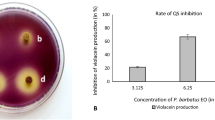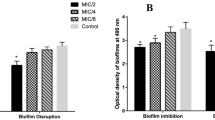Abstract
This study aimed to investigate the chemical composition, using GC–MS, and anti-biofilm potential of black cardamom essential oil (BCEO) against biofilms of Escherichia coli O157:H7 and Salmonella Typhimurium JSG 1748 through inhibition of bacterial quorum sensing. GC–MS quantification demonstrated that BCEO contains 1,8-cineole (44.24%), α-terpinyl acetate (12.25%), nerolidol (6.03%), and sabinene (5.96%) as the major bioactive compounds. Antioxidant assays for BCEO revealed the total phenolic and flavonoid mean values were 1325.03 ± 7.69 mg GAE 100/g and 168.25 ± 5.26 mg CE/g, respectively. In regards to antimicrobial potential, Candida albicans was the most sensitive species compared to Streptococcus mutans, Staphylococcus aureus, Listeria monocytogenes, Bacillus cereus, and Salmonella Typhimurium with the following zones of inhibition; 14.4 ± 0.52, 13.2 ± 0.42, 11.2 ± 0.28, 11.0 ± 0.52, 8.2 ± 0.24 and 6.6 ± 0.18 mm in diameter, respectively. Biofilm inhibition by BCEO was concentration-dependent, when various concentrations of 0.03, 0.06, 0.12, 0.25 and 0.5% were applied, 33.67, 34.14, 38.66, 46.65 and 50.17% of Salmonella Typhimurium biofilm was inhibited, while 47.31, 54.15, 76.57, 83.36 and 84.63% of Escherichia coli biofilm formation was prevented. Chromobacterium violaceum ATCC 12,472 and its product violacein, was used as a microbial indicator for enhancement or inhibition of quorum sensing. Our data showed that 0.5% of BCEO inhibited violacein production without influencing the growth of Chromobacterium violaceum, while 1% of BCEO, caused 100% inhibtion of violacein production together with 30% inhibition of growth. This study shows that BCEO possesses promising antioxidant and antimicrobial potential, and found anti-biofilm activities linked to the quenching of the quorum sensing system of E. coli and S. Typhimurium.




Similar content being viewed by others
References
Abdullah AA, Butt MS, Shahid M, Huang Q (2017) Evaluating the antimicrobial potential of green cardamom essential oil focusing on quorum sensing inhibition of Chromobacterium violaceum. J Food Sci Technol 54:2306–2315
Adams RP (2017) Identification of essential oil components by gas chromatography/mass spectrometry. Texensis Publishing Gruver, TX
Algburi A, Zehm S, Netrebov V, Bren AB, Chistyakov V, Chikindas ML (2017) Subtilosin prevents biofilm formation by inhibiting bacterial quorum sensing. Probiotics Antimicrob Protiens 9:81–90
Aneja K, Radhika J (2009) Antimicrobial activity of Amomum subulatum and Elettaria cardamomum against dental caries causing microorganisms. Ethnobotan Leafl 13:840–849
Belapurkar R, Tale VS, Madkaikar R (2014) Exploiting quorum sensing to inhibit the bacterial pathogens. Int J Curr Microbiol App Sci 3:453–458
Bhatti HN, Zafar F, Jamal MA (2010) Evaluation of phenolic contents and antioxidant potential of methanolic extracts of green cardamom (Elettaria cardamomum). Asian J Chem 22:4787–4794
Chakraborty S, Paul K, Mallick P, Pradhan S, Das K, Chakrabarti S, Bhattacharjee P (2019) Consortia of bioactives in supercritical carbon dioxide extracts of mustard and small cardamom seeds lower serum cholesterol levels in rats: new leads for hypocholesterolaemic supplements from spices. J Nutr Sci 8:1–15
Chanda S, Dave R (2009) In vitro models for antioxidant activity evaluation and some medicinal plants possessing antioxidant properties An overview. Afr J Microbiol Res 3:981–996
Chempakam B, Sindhu S (2008) Small and large cardamom; Chemistry of Spices. CABI, Cambridge, MA, pp 41–69
CLSI (2012) Performance Standards for Antimicrobial Disk Susceptibility Tests; Approved Standard-Eleventh Edition. M02-A11
Gilani SR, Shahid I, Javed M, Mehmud S, Ahmed R (2006) Antimicrobial activities and physico-chemical properties of the essential oil from Amomum subulatum. Int J Appl Chem 2:81–86
Ho S-C, Tzung-Hsun T, Po-Jung T, Chih-Cheng L (2008) Protective capacities of certain spices against peroxynitrite-mediated biomolecular damage. Food Chem Toxicol 46:920–928
Jamal M, Ahmad W, Andleeb S, Jali F, Imran M, Nazaw MA, Hussain T, Ali M, Rafiq M, Kamil MA (2018) Bacterial biofilm and associated infections. J Chin Med Assoc 81:7–11
Kerekes EB, Deak E, Tak M, Tserennadmid R, Petkovits T, Vagvolgyi C, Krisch J (2013) Anti-biofilm forming and anti-quorum sensing activity of selected essential oils and their main components on food-related microorganisms. J Appl Microbiol 115:933–942
Kumar NV, Murthy PS, Manjunatha JR, Bettadaiah BK (2014) Synthesis and quorum sensing inhibitory activity of key phenolic compounds of ginger and their derivatives. Food Chem 15:451–457
Lade H, Paul D, Kweon JH (2014) Quorum quenching mediated approaches for control of membrane biofouling. Int J Biol Sci 10:550–565
Li T, Wang D, Liu N, Ma Y, Ding T, Mei Y, Li J (2018) Inhibition of quorum sensing-controlled virulence factors and biofilm formation in Pseudomonas fluorescens by cinnamaldehyde. Int J Food Microbiol 269:98–106
Liu RH (2013) Health-promoting components of fruits and vegetables in the diet. Adv Nutr 4:384–392
Livermore DM (2011) Discovery research: the scientific challenge of finding new antibiotics. J antimicrob chemother 66:1941–1954
Miquel S, Lagrafeuille R, Souweine B, Forestier C (2016) Anti-biofilm activity as a health issue. Front Microbiol 7:592–605
Moon YJ, Wang L, DiCenzo R, Morris ME (2008) Quercetin pharmacokinetics in humans. Biopharm Drug Dispos 29:205–217
Naik JP, Rao LJM, Kumar M, Sampathu S (2004) Chemical composition of the volatile oil from the pericarp (husk) of large cardamom (Amomum subulatum Roxb.). Flav Fragr J 19:441–444
Newman DJ, Cragg GM (2016) Natural products as source of new drugs over the period 1981–2014. J Nat Prod 79:629–661
Niu C, Gilbert ES (2004) Colorimetric method for identifying plant essential oil components that affect biofilm formation and structure. Appl Environ Microbiol 70:6951–6956
Parthasarathy VA, Chempakam B, Zachariah TJ (2008) Chemistry of Spices. CABI, Cambridge, MA
Passos da Silva D, Schofield MC, Parsek MR, Tseng BS (2017) An update on the sociomicrobiology of quorum sensing in gram-negative biofilm development. Pathogens 6:51. https://doi.org/10.3390/pathogens6040051
Rahman MRT, Lou Z, Yu F, Wang P, Wang H (2017) Anti-quorum sensing and anti-biofilm activity of Amomum tsaoko (Amommum tsao-ko Crevost et Lemarie) on foodborne pathogens. Saudi J Biol Sci 24:324–330
Ramon R (2009) Oxidative stress and antioxidants: Their role in human disease. Nova publishers, NY, USA
Ray PD, Huang BW, Tsuji Y (2012) Reactive oxygen species (ROS) homeostasis and redox regulation in cellular signaling. Cell Signal 24:981–990
Rivera L, Moron R, Sanchez M, Zarzuelo A, Galisteo M (2008) Quercetin ameliorates metabolic syndrome and improves the inflammatory status in obese Zucker rats. Obesity 16:2081–2087
Rout PD, Sahoo KJ, Rao Y (2003) Analysis of the oil of large cardamom (Amomum subulatum Roxb.) growing in sikkim. J Essent Oil Res 15:265–266
Sharma S, Sharma J, Kaur G (2011) Therapeutic uses of Elettaria cardamomum. Int J Drug Formul Res 2:102–108
Thomas VP, Sabu M, Gupta U (2009) Taxonomic studies on cultivars of Amomum subulatum (Zingiberaceae). Rheedea 19:25–36
Tiveron AP, Melo PS, Bergamaschi KB, Vieira TM, Regitano-d MA, Alencar SM (2012) Antioxidant activity of Brazilian vegetables and its relation with phenolic composition. Int J Mol Sci 13:8943–8957
Torres M, Rubio-Portillo E, Anton J, Ramos-Espla AA, Quesada E, Llamas I (2016) Selection of the N-acylhomoserine lactone-degrading bacterium Alteromonas stellipolaris PQQ-42 and of its potential for biocontrol in aquaculture. Front Microbiol 7:1–13
Whiteley M, Diggle SP, Greenberg EP (2017) Bacterial quorum sensing: the progress and promise of an emerging research area. Nature 551:313–320
Ying JY, Ma JL, Xia ZL, Yao TW (2008) Pharmacokinetics of luteolin from Elsholtzia blanda extracts in rats. Acta Pharm Sin 43:523–527
Yousefi M, Rahimi-Nasrabadi M, Pourmortazavi SM, Wysokowski M, Jesionowski T, Ehrlich H, Mirsadeghi S (2019) Supercritical fluid extraction of essential oils. Trends Analyt Chem 118:182–193
Zhao J, Chen M, Quan CS, Fan SD (2015) Mechanisms of quorum sensing and strategies for quorum sensing disruption in aquaculture pathogens. J Fish Dis 38:771–786
Zhu H, He CC, Chu QH (2011) Inhibition of quorum sensing in Chromobacterium violaceum by pigments extracted from Auricularia auricular. Lett Appl Microbiol 52:269–274
Acknowledgements
The authors gratefully recognized the support of Higher Education Commission (HEC), Pakistan and Rutgers, The State University of New Jersey, USA to accomplish present research work. Abdullah was financially supported by the postdoc office of the Zhejiang University, Hangzhou, China. MLC was supported by the Ministry of Science and Higher Education of the Russian Federation (Project Number 075-15-2019-1880).
Author information
Authors and Affiliations
Corresponding authors
Additional information
Publisher's Note
Springer Nature remains neutral with regard to jurisdictional claims in published maps and institutional affiliations.
Rights and permissions
About this article
Cite this article
Abdullah, Algburi, A., Asghar, A. et al. Black cardamom essential oil prevents Escherichia coli O157:H7 and Salmonella Typhimurium JSG 1748 biofilm formation through inhibition of quorum sensing. J Food Sci Technol 58, 3183–3191 (2021). https://doi.org/10.1007/s13197-020-04821-8
Revised:
Accepted:
Published:
Issue Date:
DOI: https://doi.org/10.1007/s13197-020-04821-8




